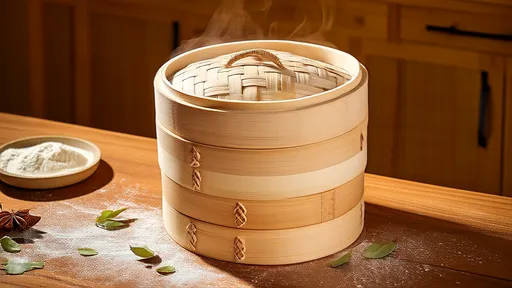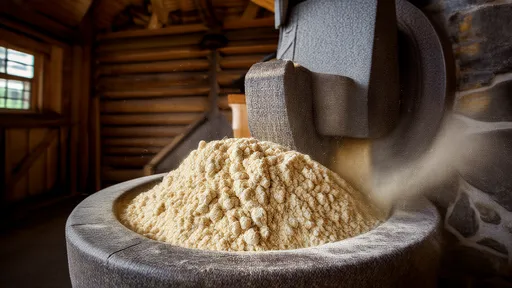The phenomenon of "cold turbidity" or "cream down" in tea has long intrigued both tea connoisseurs and scientists alike. This natural occurrence, where tea liquor turns cloudy upon cooling, is not merely an aesthetic curiosity but a window into the complex chemistry of tea. Recent advancements in optical measurement techniques have enabled researchers to quantify this phenomenon through turbidity detection based on tea liquor transmittance, opening new avenues for quality assessment and understanding of tea's molecular interactions.
At the heart of cold turbidity lies an intricate dance between tea polyphenols and caffeine. When hot water extracts these compounds during brewing, they form soluble complexes that remain transparent in solution. However, as the temperature drops, these complexes undergo structural changes, forming larger colloidal particles that scatter light. The degree of this turbidity can be precisely measured through transmittance analysis, where a beam of light passes through the cooled tea liquor and the intensity of transmitted light is quantified.
The measurement process reveals far more than simple cloudiness. Specialized spectrophotometers equipped with temperature control chambers can track the turbidity development in real-time as the tea cools from brewing temperature to room temperature. This dynamic profiling provides valuable data about the kinetics of complex formation, with different tea varieties exhibiting distinct turbidity curves. High-quality teas often show a gradual, uniform increase in turbidity rather than sudden precipitation.
Interestingly, the transmittance-turbidity relationship in tea isn't linear across all wavelengths. Researchers have found that measurements at specific wavelengths, particularly around 650 nm where tea pigments minimally interfere, yield the most accurate turbidity assessments. This spectral selectivity allows for more precise differentiation between desirable cold turbidity (indicative of rich polyphenol content) and undesirable haze caused by impurities or poor processing.
Practical applications of this technology are transforming tea quality control. Traditional methods of assessing cold turbidity relied on subjective visual inspection, leaving room for inconsistency. Modern turbidimeters can now provide numerical values - typically in Nephelometric Turbidity Units (NTU) - that correlate with chemical composition. Factories are implementing these measurements as part of standardized quality protocols, particularly for premium teas where cold turbidity is considered a mark of excellence.
The science behind these measurements has revealed unexpected nuances. For instance, the ratio of transmitted light at two different wavelengths (turbidity ratio) can indicate whether cloudiness stems from protein-polyphenol complexes (desirable) or starch residues (processing flaw). Such discrimination was impossible with traditional visual assessment. Moreover, the temperature at which turbidity first appears (turbidity point) has emerged as a sensitive indicator of tea grade, with higher-quality teas generally showing earlier onset.
Field studies comparing transmittance-based turbidity measurements with chemical assays have yielded fascinating correlations. Teas displaying moderate turbidity (40-60% transmittance at 650 nm after cooling to 10°C) consistently test higher in bioactive compounds like EGCG while maintaining good clarity when hot. This optimal range appears to reflect a balanced composition where polyphenols and caffeine exist in proportions that create stable, light-scattering colloids rather than coarse precipitates.
Beyond quality control, this technology is reshaping tea research. Scientists are using precise turbidity measurements to study how growing conditions, processing methods, and storage affect the molecular interactions in tea. Early findings suggest that shading tea plants before harvest increases the polyphenols responsible for desirable cold turbidity, while excessive fermentation can lead to unstable complexes that produce uneven cloudiness. Such insights are helping growers optimize practices for specific tea characteristics.
The cultural significance of these measurements shouldn't be overlooked. In many traditional tea cultures, the appearance of "tea cream" is considered a mark of quality and skill. By quantifying this phenomenon, modern science isn't replacing traditional knowledge but rather providing tools to understand and preserve it. The ability to measure cold turbidity objectively helps protect against adulteration while maintaining the aesthetic qualities prized by tea enthusiasts for centuries.
Looking ahead, researchers are exploring more sophisticated applications of transmittance-based turbidity analysis. Some are investigating whether the spectral characteristics of cold turbidity could serve as a fingerprint for tea origin authentication. Others are developing portable turbidity sensors that could allow real-time monitoring during tea processing. As these technologies mature, they promise to deepen our understanding of tea chemistry while preserving the artisanal qualities that make each cup unique.
The marriage of ancient tea wisdom and modern optical technology exemplifies how traditional food sciences can benefit from precision measurement. What was once judged by eye can now be understood at the molecular level, yet the ultimate test remains the same - the pleasure of drinking a well-crafted tea, whose fleeting clouds tell a story of chemistry, craft, and centuries of tradition.
The art of baking a perfect cake relies heavily on understanding the science behind its structure. Among the many factors that contribute to a cake's texture, the uniformity of air pockets within the cake crumb stands out as a critical element. This characteristic is largely influenced by the foaming properties of proteins in the batter, particularly those found in eggs. The way proteins trap and stabilize air bubbles during mixing directly impacts the final product's lightness, tenderness, and overall mouthfeel.
The world of sensory evaluation is as intricate as it is fascinating, particularly when it comes to understanding how we perceive flavors and aromas. Among the myriad of compounds that contribute to our sensory experiences, vanillin—the primary component of vanilla extract—stands out for its widespread use and complex interaction with our senses. The concept of odor threshold plays a pivotal role in determining how much of this compound is needed for it to be detectable, and it varies significantly depending on the medium in which it is presented.
The world of chili peppers is as diverse as it is fiery, with each variety packing its own unique punch. At the heart of understanding this heat lies the Scoville Scale, a measurement that quantifies the spiciness of peppers. Developed by Wilbur Scoville in 1912, this scale remains the gold standard for gauging the capsaicin content—the compound responsible for that burning sensation—in different peppers. From the mild bell pepper to the mind-numbing Carolina Reaper, the Scoville Scale offers a fascinating glimpse into the spectrum of heat that chili enthusiasts chase.
The culinary world has long celebrated the magic that happens when certain ingredients come together, creating flavors greater than the sum of their parts. One such pairing—chicken broth and mushrooms—exemplifies the scientific and gastronomic phenomenon known as umami synergy. This dynamic duo has been a staple in kitchens across cultures, from French consommé to Japanese ramen, and its power lies in the way their compounds interact to amplify savory depth.
The world of fermented foods is a fascinating intersection of microbiology, chemistry, and culinary tradition. Among these, kimchi stands out not only for its bold flavors but also for the intricate biochemical processes that transform raw vegetables into a probiotic-rich delicacy. At the heart of this transformation lies a phenomenon known as acetic acid penetration, which creates a dynamic pH gradient during fermentation. This process is far more than a simple souring of cabbage—it's a carefully orchestrated dance between microbial communities and their chemical environment.
The turbidity of fruit juice, often perceived as a mark of freshness and natural quality, is primarily governed by the suspension mechanisms of pulp particles. These tiny fragments of fruit flesh, ranging from cellular debris to larger fibrous clusters, create the characteristic cloudiness that consumers associate with premium products. Behind this seemingly simple phenomenon lies a complex interplay of physical forces, biochemical interactions, and processing variables that determine whether pulp remains evenly dispersed or separates over time.
The fizz in your soda isn't just about taste—it's a carefully engineered dance between gas and liquid that begins unraveling the moment you twist open the cap. Few consumers realize how precisely carbonation levels are calibrated, or how dramatically pressure dynamics shift during that first explosive release. This invisible physics experiment in every bottle follows predictable but fascinating patterns that beverage scientists have spent decades mapping.
The world of espresso is as complex as it is captivating, with its rich flavors and aromatic allure. At the heart of this complexity lies a seemingly simple yet scientifically intricate component: the crema. This golden-brown layer of foam that crowns a well-pulled shot of espresso is not just a visual delight but a fascinating study in colloidal stability. The interplay of oils, gases, and solids in espresso crema reveals a delicate balance that defines the quality and texture of the coffee.
The phenomenon of "cold turbidity" or "cream down" in tea has long intrigued both tea connoisseurs and scientists alike. This natural occurrence, where tea liquor turns cloudy upon cooling, is not merely an aesthetic curiosity but a window into the complex chemistry of tea. Recent advancements in optical measurement techniques have enabled researchers to quantify this phenomenon through turbidity detection based on tea liquor transmittance, opening new avenues for quality assessment and understanding of tea's molecular interactions.
The world of instant noodles thrives on convenience, but behind that simplicity lies a carefully engineered marvel of food science. At the heart of this innovation sits pregelatinized starch—an unsung hero that transforms dehydrated noodles into a steaming bowl of comfort within minutes. Unlike traditional starch, pregelatinized starch undergoes a thermal and mechanical treatment that breaks down its granular structure, allowing it to absorb water rapidly. This property is pivotal for instant noodles, where rehydration speed and texture determine consumer satisfaction.
The world of traditional fermented foods holds countless microbial secrets, and few are as fascinating as the complex ecosystem of laomian – the centuries-old sourdough starter that gives Chinese steamed bread its distinctive character. While modern bakeries increasingly rely on commercial yeast, artisanal producers across northern China still maintain their family laomian cultures like precious heirlooms, passing down not just techniques but living microbial communities through generations.
The sticky, chewy texture of glutinous rice cakes, known as mochi in Japanese or nuòmǐ cí in Chinese, has long been a staple in East Asian cuisine. These delectable treats, often enjoyed during festivals or as everyday snacks, owe their unique consistency to a key component: amylopectin, the branched-chain starch found in glutinous rice. However, anyone who has left mochi or Chinese mochi cakes (糍粑) at room temperature for a few hours will notice an unmistakable transformation—the once-soft and pliable dessert gradually hardens, becoming tougher and less enjoyable. This phenomenon, often referred to as retrogradation, is a fascinating interplay of chemistry, physics, and culinary science.
The art of cooking perfect rice lies in understanding the gelatinization temperature of different japonica rice varieties. This scientific parameter, often overlooked by home cooks, determines the precise moment when starch granules absorb water and swell—fundamentally shaping texture, flavor release, and nutritional accessibility. Recent studies across Asian research institutions reveal how subtle genetic variations in short-grain rice cultivars create distinct thermal behaviors during cooking, challenging the one-size-fits-all approach to water ratios and heat application.
The art of crafting perfect hand-pulled noodles lies in mastering the delicate balance between gluten development and dough relaxation. Among the many variables that influence noodle extensibility, resting time stands as one of the most critical yet often overlooked factors. This silent alchemy occurring during the waiting period transforms a stiff, unyielding mass into an elastic, cooperative material ready to be stretched into silky strands.
For generations, home cooks and professional chefs alike have relied on stainless steel containers for pickling and food storage. The material's reputation for durability and corrosion resistance makes it a seemingly ideal choice. But when acidic ingredients like vinegar enter the equation, questions arise about potential metal leaching and food safety. Understanding the interaction between stainless steel and pickling brines requires a deeper dive into metallurgy, chemistry, and culinary science.
The bamboo steamer, a centuries-old culinary tool cherished across Asian kitchens, operates on principles far more sophisticated than its simple appearance suggests. Among its most fascinating phenomena is the so-called "bamboo steamer effect" – a self-regulating mechanism that prevents the dreaded condensation drip-back, ensuring perfectly textured dumplings, buns, and fish every time. This natural engineering marvel has captivated chefs and scientists alike, revealing how traditional wisdom often anticipates modern food science.
The age-old practice of stone milling has long been revered for its ability to produce flour that retains the natural goodness of whole grains. Unlike modern industrial milling methods, which often prioritize speed and shelf life, stone grinding operates at a slower pace, preserving the integrity of the grain’s nutritional profile. One of the most significant advantages of this traditional method is its ability to maintain higher levels of dietary fiber in whole wheat flour—a component essential for digestive health, blood sugar regulation, and overall well-being.
















